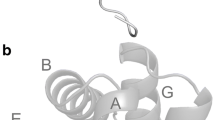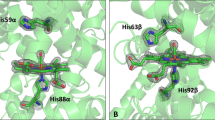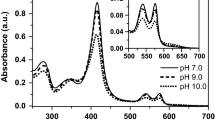Abstract
Giant extracellular hexagonal bilayer hemoglobin (HBL-Hb), found only in annelids, is an ∼3500-kDa heteropolymeric structure involved in oxygen transport. The HBL-Hbs are comprised of globin and linker chains, the latter being required for the assembly of the quaternary structure. The linker chains, varying in size from 225 to 283 amino acids, have a conserved cysteine-rich domain within their N-terminal moiety that is homologous to the cysteine-rich modules constituting the ligand binding domain of the low-density lipoprotein receptor (LDLR) protein family found in many metazoans. We have investigated the gene structure of linkers from Arenicola marina, Alvinella pompejana, Nereis diversicolor, Lumbricus terrestris, and Riftia pachyptila. We found, contrary to the results obtained earlier with linker genes from N. diversicolor and L. terrestris, that in all of the foregoing cases, the linker LDL-A module is flanked by two phase 1 introns, as in the human LDLR gene, with two more introns in the 3′ side whose positions varied with the species. In addition, we obtained 13 linker cDNAs that have been determined experimentally or found in the EST database LumbriBASE. A molecular phylogenetic analysis of the linker primary sequences demonstrated that they cluster into two distinct families of linker proteins. We propose that the common gene ancestor to annelid linker genes exhibited a four-intron and five-exon structure and gave rise to the two families subsequent to a duplication event.




Similar content being viewed by others
References
Atkins AR, Brereton IM, Kroon PA, Lee HT, Smith R (1998) Calcium is essential for the structural integrity of the cysteine-rich, ligand-binding repeat of the low-density lipoprotein receptor. Biochemistry 37:1662–1670
Bailly X, Jollivet D, Vanin S, Deutsch J, Zal F, Lallier F, Toulmond A (2002) Evolution of the sulfide-binding function within the globin multigenic family of the deep-sea hydrothermal vent tubeworm Riftia pachyptila. Mol Biol Evol 19:1421–1433
Bates P, Young JA, Varmus HE (1993) A receptor for subgroup A Rous sarcoma virus is related to the low density lipoprotein receptor. Cell 74:1043–1051
Bendtsen JD, Nielsen H, von Heijne G, Brunak S (2004) Improved prediction of signal peptides: SignalP 3.0. J Mol Biol 340:783–795
Bieri S, Djordjevic JT, Daly NL, Smith R, Kroon PA (1995) Disulfide bridges of a cysteine-rich repeat of the LDL receptor ligand-binding domain. Biochemistry 34:13059–13065
Brown MS, Goldstein JL (1986) A receptor-mediated pathway for cholesterol homeostasis. Science 232:34–47
Chen N, Harris TW, Antoshechkin I, Bastiani C, Bieri T, Blasiar D, Bradnam K, Canaran P, Chan J, Chen CK, Chen WJ, Cunningham F, Davis P, Kenny E, Kishore R, Lawson D, Lee R, Muller HM, Nakamura C, Pai S, Ozersky P, Petcherski A, Rogers A, Sabo A, Schwarz EM, Van Auken K, Wang Q, Durbin R, Spieth J, Sternberg PW, Stein LD ((31 co-authors). 2005) WormBase: a comprehensive data resource for Caenorhabditis biology and genomics. Nucleic Acids Res 33:D383–D389
Dirlam KA, Gretch DG, LaCount DJ, Sturley SL, Attie AD (1996) Expression and characterization of a truncated, soluble, low-density lipoprotein receptor. Protein Expr Purif 8:489–500
DiScipio RG, Gehring MR, Podack ER, Kan CC, Hugli TE, Fey GH (1984) Nucleotide sequence of cDNA and derived amino acid sequence of human complement component C9. Proc Natl Acad Sci USA 81:7298–7302
Edgar RC (2004) MUSCLE: multiple sequence alignment with high accuracy and high throughput. Nucleic Acids Res 32:1792–1797
Fass D, Blacklow S, Kim PS, Berger JM (1997) Molecular basis of familial hypercholesterolaemia from structure of LDL receptor module. Nature 388:691–693
Fushitani K, Higashiyama K, Asao M, Hosokawa K (1996) Characterization of the constituent polypeptides of the extracellular hemoglobin from Lumbricus terrestris: heterogeneity and discovery of a new linker chain L4. Biochim Biophys Acta 1292:273–280
Gotoh T, Shishikura F, Snow JW, Ereifej KI, Vinogradov SN, Walz DA (1987) Two globin strains in the giant annelid extracellular haemoglobins. Biochem J 241:441–445
Gotoh T, Sano T, Shibuya A, Yamaki M, Imai K, Ebina S (1998) Hexagonal bilayer structuring activity of linker chains of an annelid giant hemoglobin from the polychaete Perinereis aibuhitensis. Arch Biochem Biophys 360:75–84
Guindon S, Gascuel O (2003) A simple, fast, and accurate algorithm to estimate large phylogenies by maximum likelihood. Syst Biol 52:696–704
Guo Y, Yu X, Rihani K, Wang QY, Rong L (2004) The role of a conserved acidic residue in calcium-dependent protein folding for a low density lipoprotein (LDL)-A module: implications in structure and function for the LDL receptor superfamily. J Biol Chem 279:16629–16637
Hardison R (1998) Hemoglobins from bacteria to man: evolution of different patterns of gene expression. J Exp Biol 201 (Pt 8):1099–1117
Hou S, Belisle C, Lam S, Piatibratov M, Sivozhelezov V, Takami H, Alam M (2001) A globin-coupled oxygen sensor from the facultatively alkaliphilic Bacillus halodurans C-125. Extremophiles 5:351–354
Imai K (1999) The haemoglobin enzyme. Nature 401:437–439
Jones DT, Taylor WR, Thornton JM (1992) The rapid generation of mutation data matrices from protein sequences. Comput Appl Biosci 8:275–282
Keller EB, Noon WA (1984) Intron splicing: a conserved internal signal in introns of animal pre-mRNAs. Proc Natl Acad Sci USA 81:7417–7420
Kitamoto Y, Yuan X, Wu Q, McCourt DW, Sadler JE (1994) Enterokinase, the initiator of intestinal digestion, is a mosaic protease composed of a distinctive assortment of domains. Proc Natl Acad Sci USA 91:7588–7592
Kuchumov AR, Taveau JC, Lamy JN, Wall JS, Weber RE, Vinogradov SN (1999) The role of linkers in the reassembly of the 3.6 MDa hexagonal bilayer hemoglobin from Lumbricus terrestris. J Mol Biol 289:1361–1374
Kuchumov AR, Loo JA, Vinogradov SN (2000) Subunit distribution of calcium-binding sites in Lumbricus terrestris hemoglobin. J Protein Chem 19:139–149
Lamy JN, Green BN, Toulmond A, Wall JS, Weber RE, Vinogradov SN (1996) Giant hexagonal bilayer hemoglobins. Chem Rev 96:3113–3124
Lamy J, Kuchumov A, Taveau JC, Vinogradov SN, Lamy JN (2000) Reassembly of Lumbricus terrestris hemoglobin: a study by matrix-assisted laser desorption/ionization mass spectrometry and 3D reconstruction from frozen-hydrated specimens. J Mol Biol 298:633–647
Lee MS, Cho SJ, Lee JA, Park BJ, Cho HJ, Moon JS, Kim SK, Choo JK, Park SC (2004) Transcriptome analysis in the midgut of the earthworm (Eisenia andrei) using expressed sequence tags. Unpublished
Lightbody JJ, Quabar AN, Mainwaring MG, Young JS, Walz DA, Vinogradov SN, Gotoh T (1988) Immunological relatedness of annelid extracellular hemoglobins and chlorocruorins. Comp Biochem Physiol B 90:301–305
Liochev SI, Kuchumov AR, Vinogradov SN, Fridovich I (1996) Superoxide dismutase activity in the giant hemoglobin of the earthworm, Lumbricus terrestris. Arch Biochem Biophys 330:281–284
Mahley RW (1988) Apolipoprotein E: cholesterol transport protein with expanding role in cell biology. Science 240:622–630
Mehta KD, Chen WJ, Goldstein JL, Brown MS (1991) The low density lipoprotein receptor in Xenopus laevis. I. Five domains that resemble the human receptor. J Biol Chem 266:10406–10414
Mount SM (1982) A catalogue of splice junction sequences. Nucleic Acids Res 10:459–472
Nagy E, Maquat LE (1998) A rule for termination-codon position within intron-containing genes: when nonsense affects RNA abundance. Trends Biochem Sci 23:198–199
Pallavicini A, Negrisolo E, Barbato R, Dewilde S, Ghiretti-Magaldi A, Moens L, Lanfranchi G (2001) The primary structure of globin and linker chains from the chlorocruorin of the polychaete Sabella spallanzanii. J Biol Chem 276:26384–26390
Patthy L (1987) Intron-dependent evolution: preferred types of exons and introns. FEBS Lett 214:1–7
Patthy L (1991) Exons—Ooriginal building blocks of proteins? Bioessays 13:187–192
Patthy L (1995) Protein evolution by exon shuffling. In: Molecular Biology Intelligence Unit. Springer, Heidelberg, pp. 136
Raychowdhury R, Niles JL, McCluskey RT, Smith JA (1989) Autoimmune target in Heymann nephritis is a glycoprotein with homology to the LDL receptor. Science 244:1163–1165
Royer WE, Jr., Strand K, van Heel M, Hendrickson WA (2000) Structural hierarchy in erythrocruorin, the giant respiratory assemblage of annelids. Proc Natl Acad Sci USA 97:7107–7111
Rudenko G, Henry L, Henderson K, Ichtchenko K, Brown MS, Goldstein JL, Deisenhofer J (2002) Structure of the LDL receptor extracellular domain at endosomal pH. Science 298:2353–2358
Saito A, Pietromonaco S, Loo AK, Farquhar MG (1994) Complete cloning and sequencing of rat gp330/”megalin”, a distinctive member of the low density lipoprotein receptor gene family. Proc Natl Acad Sci USA 91:9725–9729
Simonovic M, Dolmer K, Huang W, Strickland DK, Volz K, Gettins PG (2001) Calcium coordination and pH dependence of the calcium affinity of ligand-binding repeat CR7 from the LRP. Comparison with related domains from the LRP and the LDL receptor. Biochemistry 40:15127–15134
Stapleton M, Carlson J, Brokstein P, Yu C, Champe M, George R, Guarin H, Kronmiller B, Pacleb J, Park S, Wan K, Rubin GM, Celniker SE (2002) A Drosophila full-length cDNA resource. Genome Biol 3:RESEARCH0080
Sudhof TC, Goldstein JL, Brown MS, Russell DW (1985a) The LDL receptor gene: a mosaic of exons shared with different proteins. Science 228:815–822
Sudhof TC, Russell DW, Goldstein JL, Brown MS, Sanchez-Pescador R, Bell GI (1985b) Cassette of eight exons shared by genes for LDL receptor and EGF precursor. Science 228:893–895
Suzuki T, Riggs AF (1993) Linker chain L1 of earthworm hemoglobin. Structure of gene and protein: homology with low density lipoprotein receptor. J Biol Chem 268:13548–13555
Suzuki T, Vinogradov SN (2003) Globin and linker sequences of the giant extracellular hemoglobin from the leech Macrobdella decora. J Protein Chem 22:231–242
Suzuki T, Takagi T, Gotoh T (1990a) Primary structure of two linker chains of the extracellular hemoglobin from the polychaete Tylorrhynchus heterochaetus. J Biol Chem 265:12168–12177
Suzuki T, Takagi T, Ohta S (1990b) Primary structure of a linker subunit of the tube worm 3000-kDa hemoglobin. J Biol Chem 265:1551–1555
Suzuki T, Ohta T, Yuasa HJ, Takagi T (1994) The giant extracellular hemoglobin from the polychaete Neanthes diversicolor. The cDNA-derived amino acid sequence of linker chain L2 and the exon/intron boundary conserved in linker genes. Biochim Biophys Acta 1217:291–296
Takahashi S, Kawarabayasi Y, Nakai T, Sakai J, Yamamoto T (1992) Rabbit very low density lipoprotein receptor: a low density lipoprotein receptor-like protein with distinct ligand specificity. Proc Natl Acad Sci USA 89:9252–9256
Tensen CP, Van Kesteren ER, Planta RJ, Cox KJ, Burke JF, van Heerikhuizen H, Vreugdenhil E (1994) A G protein-coupled receptor with low density lipoprotein-binding motifs suggests a role for lipoproteins in G-linked signal transduction. Proc Natl Acad Sci USA 91:4816–4820
van Driel IR, Goldstein JL, Sudhof TC, Brown MS (1987) First cysteine-rich repeat in ligand-binding domain of low density lipoprotein receptor binds Ca2+ and monoclonal antibodies, but not lipoproteins. J Biol Chem 262:17443–17449
Vinogradov SN (1985) The structure of invertebrate extracellular hemoglobins (erythrocruorins and chlorocruorins). Comp Biochem Physiol B 82:1–15
Vinogradov SN, Lugo SD, Mainwaring MG, Kapp OH, Crewe AV (1986) Bracelet protein: a quaternary structure proposed for the giant extracellular hemoglobin of Lumbricus terrestris. Proc Natl Acad Sci USA 83:8034–8038
Vinogradov SN, Walz DA, Pohajdak B, Moens L, Kapp OH, Suzuki T, Trotman CN (1993) Adventitious variability? The amino acid sequences of nonvertebrate globins. Comp Biochem Physiol B 106:1–26
Weber RE, Vinogradov SN (2001) Nonvertebrate hemoglobins: functions and molecular adaptations. Physiol Rev 81:569–628
Yochem J, Greenwald I (1993) A gene for a low density lipoprotein receptor-related protein in the nematode Caenorhabditis elegans. Proc Natl Acad Sci USA 90:4572–4576
Zal F, Lallier FH, Wall JS, Vinogradov SN, Toulmond A (1996) The multi-hemoglobin system of the hydrothermal vent tube worm Riftia pachyptila. I. Reexamination of the number and masses of its constituents. J Biol Chem 271:8869–8874
Zal F, Green BN, Lallier FH, Toulmond A (1997a) Investigation by electrospray ionization mass spectrometry of the extracellular hemoglobin from the polychaete annelid Alvinella pompejana: an unusual hexagonal bilayer hemoglobin. Biochemistry 36:11777–11786
Zal F, Green BN, Lallier FH, Vinogradov SN, Toulmond A (1997b) Quaternary structure of the extracellular haemoglobin of the lugworm Arenicola marina: a multi-angle-laser-light-scattering and electrospray-ionisation-mass-spectrometry analysis. Eur J Biochem 243:85–92
Zhang J, Sun X, Qian Y, Maquat LE (1998a) Intron function in the nonsense-mediated decay of beta-globin mRNA: indications that pre-mRNA splicing in the nucleus can influence mRNA translation in the cytoplasm. RNA 4:801–815
Acknowledgments
We are indebted to Serge Vinogradov for his critical reading and comments on the manuscript. We thank the captains and crews of the NO L’Atalante and the pilots, cruises, and team of the submersibles Nautile and Alvin of the HOT 96, HOPE’99, LARVE99, and BIOSPEEDO. We thank the referees for helpful discussion. This work was supported by the CNRS, European grant FEDER presage 3814, and the Conseil Régional de Bretagne (contract A2C809).
Author information
Authors and Affiliations
Corresponding author
Rights and permissions
About this article
Cite this article
Chabasse, C., Bailly, X., Sanchez, S. et al. Gene Structure and Molecular Phylogeny of the Linker Chains from the Giant Annelid Hexagonal Bilayer Hemoglobins. J Mol Evol 63, 365–374 (2006). https://doi.org/10.1007/s00239-005-0198-9
Received:
Accepted:
Published:
Issue Date:
DOI: https://doi.org/10.1007/s00239-005-0198-9




